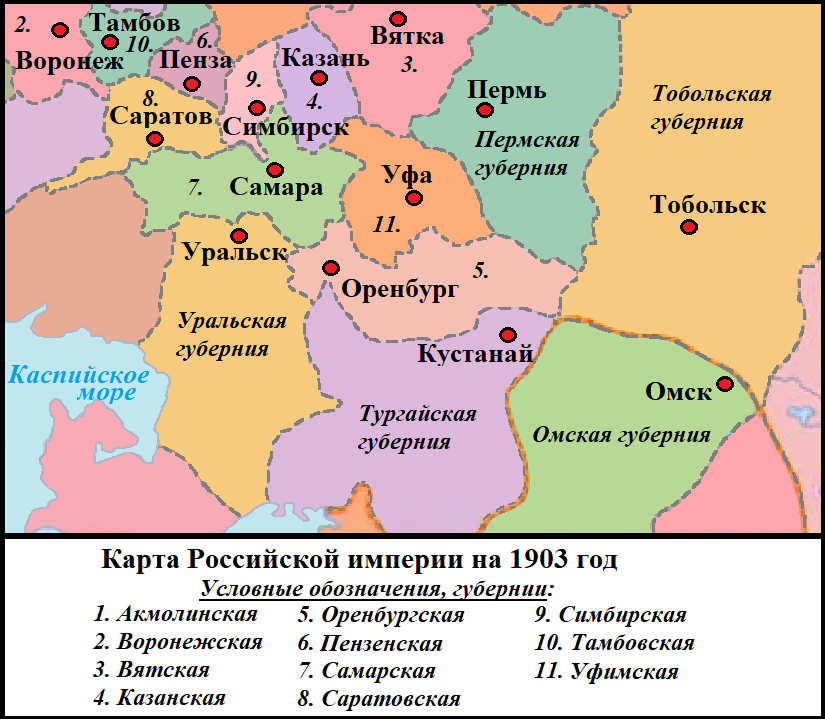After the collapse of the Soviet Union, a new sovereignty parade began, but already on the territory of Russia. As a result, some regions have declared their sovereignty and want to secede from Russia (read more about this here). However, several areas in the Orenburg region were conditionally called the "Kuwandik Corridor", and Russia was able to retain its territory in the 90s. But what is this corridor, and what does Joseph Stalin have to do with it? That's what we're going to talk about today.
It is well known that during the period of the Russian Empire there was no national republic, since the territory of the country was divided only into provinces and regions. Thus, in those years there was neither Tatarstan, nor Bashkirya, nor even Kazakhstan, but in its place the provinces of Kazan, Ufa and Orenburg, as well as the steppe and Semilechensk Cossack regions. But in these territories, in addition to the Russians, there were Also Turkic peoples such as Tatars, Bashkirs, kazakhs, etc., which began to carry out separatist movements after the collapse of the Russian Empire.

Map of the Ural Province of the Russian Empire in 1903 (map digitized by the author of the article)
After the end of the civil war, the Bolsheviks began to pursue a policy of territorial division of the country, and kazan and Ufa provinces became autonomous republics of Tatarstan and Bashkortostan. At the same time, Orenburg Province was incorporated into the Kazakh Kyrgyz Autonomous Socialist Republic, and the city of Orenburg became its capital. As a result, the Russian Turkic Republic directly borders the Kyrgyz Republic (the future Kazakh Soviet Socialist Republic), which theoretically means that these autonomous oblasts may be separated from Russia in the future.
Kirgiz ASSR map (image taken from open source)
But in 1925, Soviet leaders withdrew Orenburg Province from the Kyrgyz Soviet Union (Soviet Kazakhstan) and handed it over directly to the Russian Federation. In the same year, the Gesky and Kuwandik districts left the Kyrgyz Republic and became part of the Orenburg region. To avoid future divisions, Joseph Stalin decreed that the Turkic Areas of Geisky and Kuwandek would be settled by Slavic populations, and by the mid-1930s the Russians had begun to overwhelm the local Tatars. Thus, with the help of the Russian-speaking Gatsky and Kuwandek regions, Stalin created the so-called "Kuwandek Corridor" separating the two Turkic republics. Subsequently, the corridor was repeatedly expanded in accordance with the decision of "clear boundaries".
Orenburg area and the Kuvandyk corridor (Image from public sources)
In 1936, the "Stalinist" constitution elevated the status of a partially autonomous republic to a federal republic, and in the same year the Kyrgyz Soviet was upgraded to a federal republic, transforming it into an independent Kazakh Soviet Socialist Republic. According to the Constitution, the Union Republics had the right to freely secede from the USSR. In order to realize this possibility, they must have common borders with external countries. Because of the Kuvandyk Corridor, Bashkortostan does not meet this criterion – even though soviet troops have left Kazakhstan. As a result, the Republic of Bashkir maintained its Soviet status, although it could rival many Federal Republics in terms of territory and population.
Kazakhstan and the Central Asian Republic (Image from public sources)
In 1991, the Soviet Union ceased to exist as a state, and Kazakhstan withdrew from Russia. In Russia itself, however, all previous autonomous republics became national republics, some of which gained sovereign status. For example, Tatarstan and Bashkortostan held a referendum on state sovereignty in 1992. Throughout the "90s", both Tatarstan and Bashkortostan wanted to establish a "Union of Turkic Peoples of the Volga Region", but this plan was blocked by the same "Kuwandek Corridor" in the Orenburg region, which did not allow Bashkirs and Tatars to reach the outer border. The delegation of the Republic of Bashkortostan had repeatedly proposed to the leaders of the Orenburg region that the Gäsky and Kuwandek districts should be handed over to them in order to destroy the Kuwandek Corridor, but to no avail.
Throughout the "90s", both Tatarstan and Bashkortostan wanted to establish a "Union of Turkic Peoples of the Volga Region", but this plan was blocked by the same "Kuwandik Corridor"
conclusion. The Kuwandik Corridor was created as early as 1936, and Joseph Stalin seemed to be looking at the water because, thanks to this corridor, Russia in the 1990s was able to avoid the Tatar and Bashkir corridors. In fact, according to the American political scientist Paul Goble and the Ukrainian researcher Pavel Podobede, "The Kuwandek Corridor is the lever that launched the process of secession of the six Volga Republics from the Russian Federation."